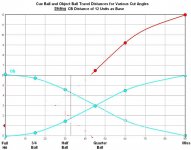Patrick Johnson said:
Dick, you're certainly right that a skilled player's "feel" for distance and speed can't be approached by an unskilled player with a chart...
pj
chgo
Patrick,
While it's a valuable tool for teaching low skilled players I wouldn't underestimate the value of these rule of thumb ratios for advanced players.
While I'm no Efren Reyes, and not intending to brag, just pointing out that I'm not a beginner, I used the 1/6th ratio maybe a dozen or more times during matches in last years national championships where I made the semis. I find it helps me to pin-point CB position on quite a few shots.
For example, it's sometimes very good for determining the following:
1. If you'll get just past, or just short of straight in position on the next ball.
2. If you'll stop just short of or just past a snooker.
I think many players can feel the speed they will roll the OB more than they can feel the speed they will roll the CB through the OB on straightish shots,
especially when they move onto different speed tables. Not inch for inch, but inch per half foot. The ratio kind of leverages the degree of accuracy, much like how a player would have better speed control with a light cue as compared to a 30 ounce cue.
So if they can judge the OB travel distance to within a foot, they are able to calculate the CB travel distance to within 2 inches.
I think it also has the advantage of just being able to focus on one variable.
btw: I had a very good snooker player trying to advise me to play stun through shots after noticing I was dribbling a few balls in, not realizing there was some method to my madness. Judging stun through shots to within 2 inches is a heck of a task, especially when moving between tables of varying cloth speeds.
The dribble, or roll in shot is often considered a beginner method, but I think it is under utilized because it is a shot that can be developed with quite high precision.
As an interesting aside: In snooker and other smaller ball and smaller pocket games, kicks (skids) often make slow rolling shots a risky choice, but it doesn't occur as often, nor have such disastrous consequences in US pool (assuming the tables are pretty level).
Colin
